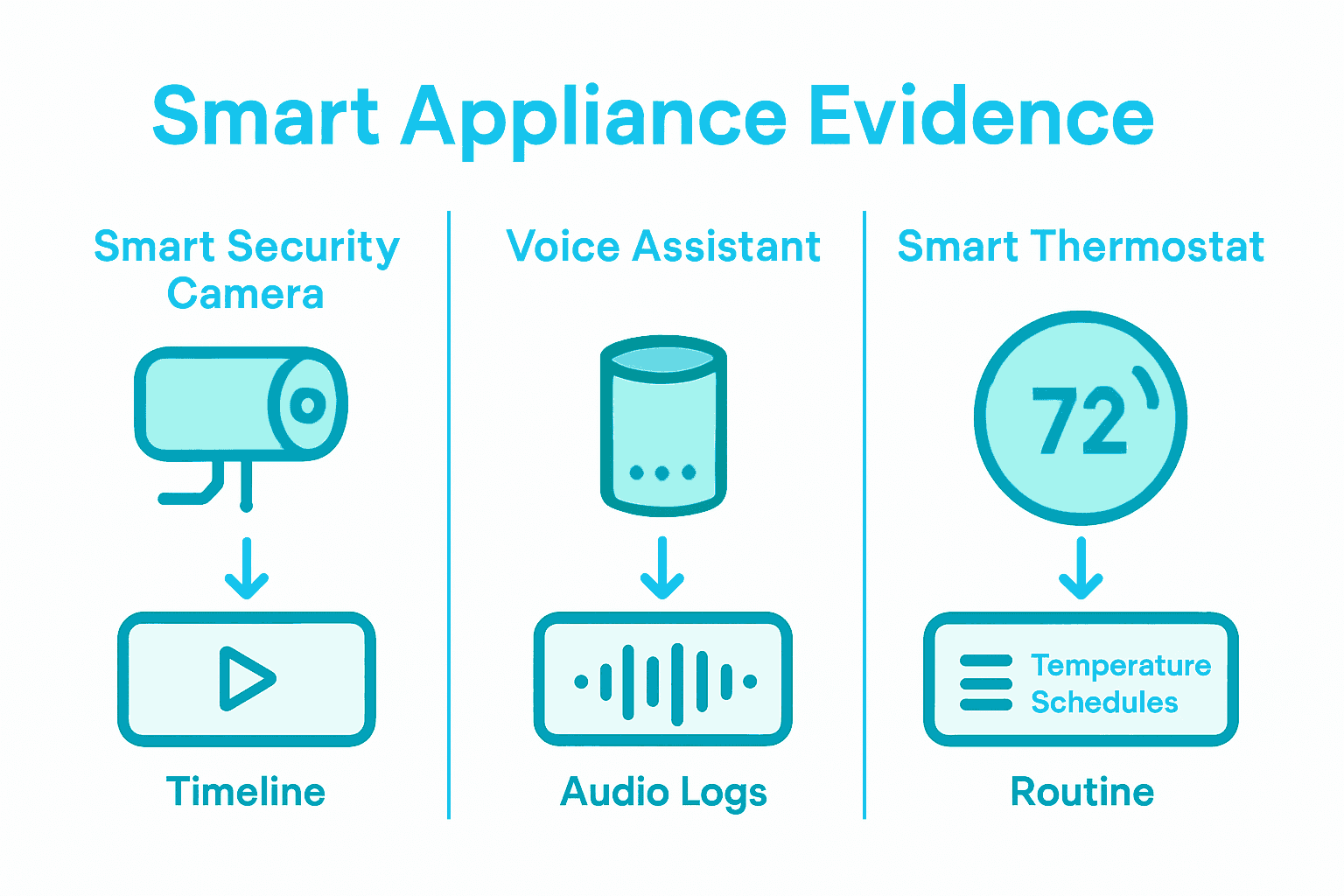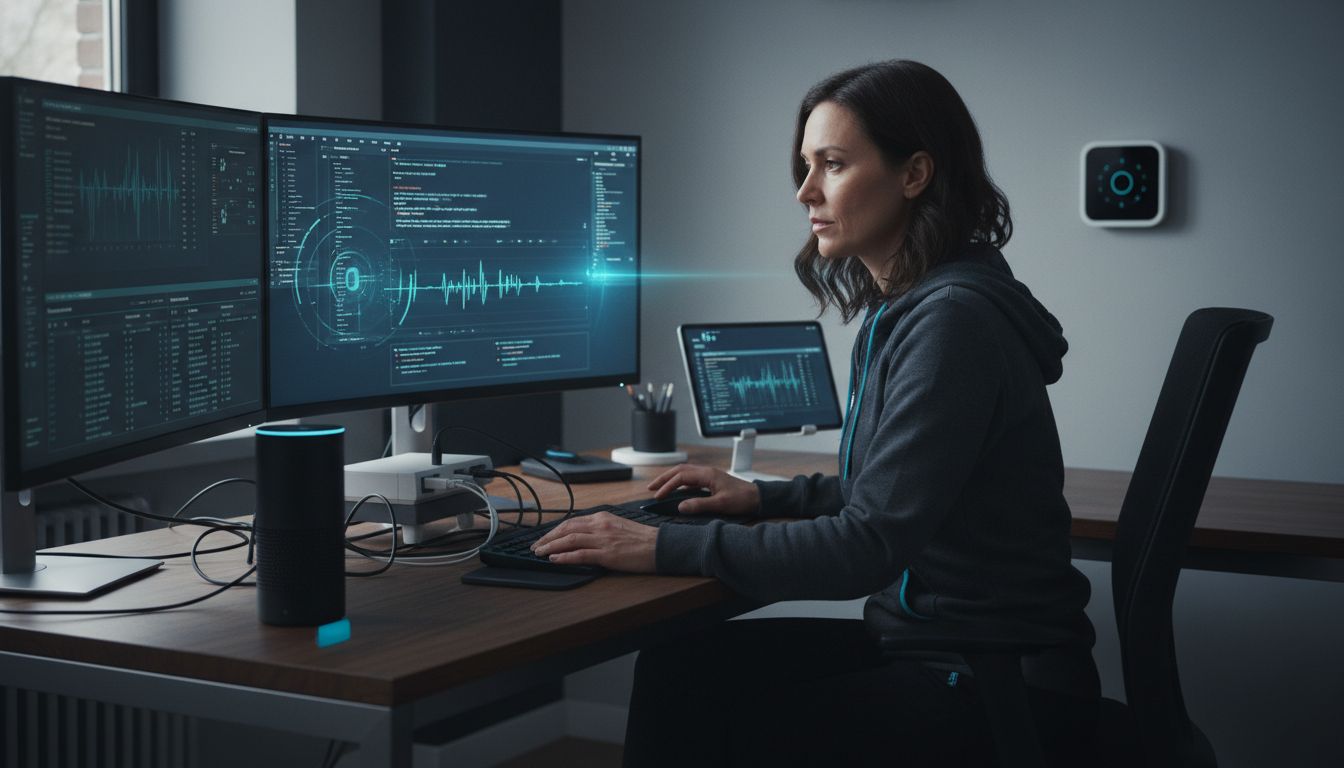Did you know that over 75 percent of households now use at least one smart appliance, turning millions of ordinary homes into valuable sources of digital evidence? This surge in connected devices has created new opportunities and challenges for digital investigations. Understanding how experts recover, examine, and protect digital traces from smart appliances can reveal important information about daily activities and even help solve complex legal cases.
Table of Contents
- Defining Digital Forensics In Smart Appliances
- Types Of Smart Appliance Evidence And Devices
- Data Extraction Methods And Analysis Techniques
- Legal And Regulatory Compliance In Forensics
- Risks, Challenges, And Best Practice Solutions
Key Takeaways
| Point | Details |
|---|---|
| Digital Forensics in Smart Appliances | This field analyzes data from IoT devices to gather critical evidence related to events and human activities in smart home environments. |
| Diverse Sources of Evidence | Key devices like security cameras and voice assistants generate digital artifacts that can provide valuable insights into user interactions and behaviors. |
| Advanced Analysis Techniques | Sophisticated methods, such as electromagnetic side-channel analysis, are essential for effectively extracting and preserving digital evidence from smart devices. |
| Legal Considerations and Compliance | Strict adherence to legal frameworks is crucial for ensuring the reliability and admissibility of digital evidence in judicial proceedings. |
Defining Digital Forensics in Smart Appliances
Digital forensics in smart appliances represents a cutting-edge investigative approach that transforms everyday connected devices into potential sources of critical evidence. According to research from arxiv.org, this discipline involves analyzing data generated by Internet of Things (IoT) devices within smart environments to extract forensically significant information about events and human activities.
At its core, digital forensics in smart appliances focuses on recovering and examining digital traces left behind by interconnected household technologies. arxiv.org highlights that the extensive digital footprints created by IoT devices offer unprecedented insights into human behaviors, making them invaluable for investigating potential criminal acts within smart home ecosystems.
The investigative process encompasses several key techniques:
- Extracting data from smart home devices
- Preserving digital evidence integrity
- Analyzing communication logs and sensor records
- Reconstructing potential sequences of events
- Identifying potential security breaches or unauthorized activities
These advanced forensic techniques require sophisticated technological skills, enabling investigators to transform seemingly innocuous smart appliance data into legally admissible evidence. By meticulously examining digital trails from devices like smart refrigerators, thermostats, security cameras, and voice assistants, forensic experts can uncover crucial information that might otherwise remain hidden.
Our guide on digital forensic techniques provides deeper insights into the methodologies used in this fascinating investigative domain.
Types of Smart Appliance Evidence and Devices
Smart appliance digital forensics encompasses a diverse range of interconnected devices that can provide critical investigative evidence. According to conceptechint.net, smart devices like light bulbs and floodlight cameras generate digital artifacts that are crucial in forensic investigations, revealing intricate details about user interactions and device activities.
The spectrum of forensically relevant smart appliances is remarkably broad. infonomics-society.org highlights that household IoT devices produce digital artifacts with significant investigative potential, offering unprecedented insights into user behavior and device usage patterns.
Key smart appliance evidence sources include:
- Smart security cameras
- Voice-activated digital assistants
- Smart thermostats
- Internet-connected refrigerators
- Smart lighting systems
- Wearable fitness trackers
- Connected home entertainment systems
Each device type generates unique digital traces that forensic experts can methodically analyze.

Here’s a summary of commonly encountered smart appliances and their forensic evidence types:
| Device Type | Example Evidence | Investigative Value |
|---|---|---|
| Smart Security Cameras | Video recordings Motion alerts |
Event timelines Intruder identification |
| Voice Assistants | Audio logs Command history |
User actions Interaction chronology |
| Smart Thermostats | Temperature logs Schedule records |
Presence patterns Usage anomalies |
| Connected Refrigerators | Access logs Inventory data |
Entry times Household routines |
| Smart Lighting Systems | Switch history Automation logs |
Occupancy changes Device tampering detection |
| Fitness Trackers | Movement data Biometric logs |
User location Activity verification |
| Home Entertainment Systems | Usage records Application logs |
Viewing habits Device access times |
To understand the nuanced techniques behind extracting evidence from these devices, explore our guide on digital forensic artefacts that delves deeper into their investigative significance.
Data Extraction Methods and Analysis Techniques
Digital forensic analysis of smart appliances requires sophisticated techniques that go beyond traditional investigative approaches. arxiv.org reveals a groundbreaking method of electromagnetic side-channel analysis, which enables forensic experts to inspect internal software activities of IoT devices by analyzing electromagnetic emissions during live device investigations.
The data extraction process involves multiple intricate stages designed to preserve digital evidence integrity. Forensic professionals employ a range of specialized techniques to recover and analyze digital artifacts, ensuring that the extracted information remains legally admissible and scientifically verifiable.
Key data extraction and analysis methods include:
- Live system memory forensics
- Disk image acquisition
- Network traffic analysis
- Electromagnetic side-channel investigation
- Firmware extraction and reverse engineering
- Cryptographic key recovery
- Metadata and timestamp analysis
Each extraction method requires precise technical expertise and specialized tools. Investigators must navigate complex challenges such as device encryption, proprietary software systems, and rapidly evolving technological landscapes. The goal is to uncover critical digital evidence while maintaining the chain of custody and ensuring the reliability of forensic findings.
For practitioners seeking deeper insights into digital forensic methodologies, our essential digital evidence preservation methods guide offers comprehensive strategies for modern digital investigations.
Legal and Regulatory Compliance in Forensics
Digital forensics in smart appliances demands rigorous adherence to complex legal and regulatory frameworks that ensure evidence reliability and admissibility. arxiv.org highlights the challenges presented by Anti-Digital Forensics (ADF) techniques in smart home scenarios, emphasizing the critical need for developing robust countermeasures that maintain forensic process integrity.
The legal landscape surrounding digital forensics is intricate and constantly evolving. Forensic professionals must navigate a complex web of regulations that govern digital evidence collection, preservation, and presentation. This involves maintaining strict protocols to ensure that digital artifacts can withstand legal scrutiny and meet the stringent standards required in judicial proceedings.
Key compliance considerations include:
- Obtaining proper legal authorization for evidence collection
- Maintaining chain of custody documentation
- Ensuring data privacy and consent
- Protecting individual constitutional rights
- Preventing unauthorized evidence tampering
- Documenting forensic methodologies
- Preserving original digital evidence
Forensic experts must also remain vigilant against potential challenges to evidence authenticity. This requires meticulous documentation, advanced technical skills, and a comprehensive understanding of legal requirements. The goal is to transform digital artifacts into legally admissible evidence that can withstand rigorous judicial examination.
To gain deeper insights into the legal complexities of digital investigations, explore our guide on using digital forensics in litigation, which provides comprehensive strategies for navigating the legal landscape of digital evidence.
Risks, Challenges, and Best Practice Solutions
Digital forensics in smart appliances presents a complex landscape of technological challenges and potential risks. arxiv.org highlights a critical challenge of implementing digital forensic frameworks in smart environments: maintaining high investigative accuracy while ensuring minimal performance overhead for devices and servers.
arxiv.org further emphasizes the intricate hardware complexities of IoT devices, revealing that investigating these systems requires sophisticated non-intrusive techniques like electromagnetic side-channel analysis to extract forensic data effectively.
Key risks and challenges include:
- Rapid technological obsolescence
- Complex device encryption
- Limited standardization across smart devices
- Potential data integrity compromises
- Privacy invasion concerns
- Cross-platform compatibility issues
- Advanced persistent threats
Best practice solutions demand a multifaceted approach. Forensic professionals must develop adaptive strategies that balance technical sophistication with legal and ethical considerations. This involves continuous training, investment in cutting-edge forensic tools, and maintaining a proactive approach to emerging technological challenges. The goal is to create robust investigative methodologies that can navigate the increasingly complex landscape of smart device forensics.
For practitioners seeking comprehensive strategies to address these challenges, our incident response guide offers critical insights into managing digital forensic complexities.
Unlock the Full Potential of Smart Appliance Forensics with Expert Support
Investigating digital evidence from smart appliances demands advanced skills to overcome challenges such as data encryption, device diversity, and legal compliance. If you are seeking to extract reliable evidence from complex IoT environments and ensure robust chain of custody, understanding sophisticated forensic methods like electromagnetic side-channel analysis and artifact preservation is crucial. This article highlights these challenges and points to the intricate process of transforming digital traces from smart devices into admissible evidence.
Take the next step towards resolving your smart appliance digital investigations with digital forensic investigations specialists who combine technical expertise and regulatory insight. Whether you face cyber intrusions, employee misconduct, or data breach scenarios involving connected devices, Computer Forensics Lab offers tailored solutions to recover data, analyse digital artefacts and deliver expert witness reports. Don’t wait until evidence is lost or compromised – visit Computer Forensics Lab today and discover how our comprehensive services, including computer hacking examination, can safeguard your investigation outcomes and support your litigation or cybersecurity needs.
Frequently Asked Questions
What is digital forensics in smart appliances?
Digital forensics in smart appliances involves analyzing data from Internet of Things (IoT) devices to extract important evidence related to human activities and events, turning everyday connected devices into sources of critical information for investigations.
What types of smart appliances can provide forensic evidence?
Smart appliances that can provide forensic evidence include smart security cameras, voice-activated digital assistants, smart thermostats, connected refrigerators, smart lighting systems, wearable fitness trackers, and home entertainment systems, each generating unique digital traces valuable for forensic analysis.
What are the common data extraction methods used in digital forensics?
Common data extraction methods in digital forensics include live system memory forensics, disk image acquisition, network traffic analysis, electromagnetic side-channel investigation, firmware extraction, and metadata analysis, all aimed at preserving the integrity and legality of the digital evidence.
Why is legal compliance important in digital forensics?
Legal compliance is crucial in digital forensics to ensure the reliability and admissibility of evidence. It involves following protocols for evidence collection, maintaining chain of custody, respecting data privacy, and preventing unauthorized tampering, all of which uphold the integrity of the forensic process.

